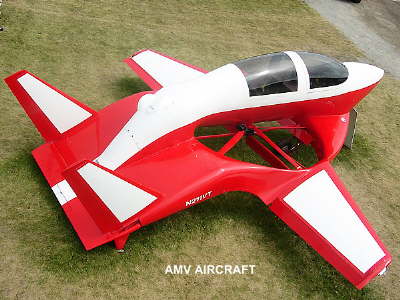| Picture |

|
| Manufacturer |
AMV Aircraft
|
| Type |
AMV-211
|
| Introduced |
1/1/2020
|
| In production? |
No
|
| Units produced |
0
|
| Price US $ |
0.00
|
| Overall Length |
20 ft
|
| Length |
20 ft
|
| Height |
0 ft
|
| Width |
20 ft
|
| |
|
| |
|
| Description |
Although not a helicopter, the AMV-211 is a VTOL (Vertical Take-Off and Landing) airplane. The performance of this aircraft should easily overcome the speed and range limits that are inherent in the design of a helicopter, mainly due to their upward thrust vector.
We already have convertiplanes, where the wing propellers are turned 90 degrees between take-off/landing and forward flight. This concept has proved to be very difficult to realize, and it took Bell and Boeing 20 years to develop the V-22 Osprey.
The AMV-211 is different, however. Here, it is not the propeller that is changing angle but the fuselage. Moreover, propulsion is not achieved with wing propellers, but with a large ducted fan that is driven by a turbine engine. A trust-vectoring device, using the thrust vector of the turbine engine outlet, counteracts the torque generated by the fan.
The driving force behind this enterprise is Attila Melkuti, the initiator of the project. The AMV-211 is still in the prototype phase (2013), and AMV is looking for investors.
|
| Advertisement |
|
| Design features |
- Turbine engine thrust-vectoring device to counter the torque caused by the propeller
- Tri-cycle wheel based landing gear
- 5 blades graphite/kevlar 94" diameter, ducted, propeller
|
Although not a helicopter, the AMV-211 is a VTOL (Vertical Take-Off and Landing) airplane. The performance of this aircraft should easily overcome the speed and range limits that are inherent in the design of a helicopter, mainly due to their upward thrust vector.
We already have convertiplanes, where the wing propellers are turned 90 degrees between take-off/landing and forward flight. This concept has proved to be very difficult to realize, and it took Bell and Boeing 20 years to develop the V-22 Osprey.
The AMV-211 is different, however. Here, it is not the propeller that is changing angle but the fuselage. Moreover, propulsion is not achieved with wing propellers, but with a large ducted fan that is driven by a turbine engine. A trust-vectoring device, using the thrust vector of the turbine engine outlet, counteracts the torque generated by the fan.
The driving force behind this enterprise is Attila Melkuti, the initiator of the project. The AMV-211 is still in the prototype phase (2013), and AMV is looking for investors.
|
|
- Advertisement -
|
Design features:
- Turbine engine thrust-vectoring device to counter the torque caused by the propeller
- Tri-cycle wheel based landing gear
- 5 blades graphite/kevlar 94" diameter, ducted, propeller
|
| Persons |
2
|
| Max. Range |
660 mi
|
| Cruise Speed |
250 mph
|
| Max. Speed |
300 mph
|
| Max. rate of Climb |
4500 ft/min
|
| HOGE ceiling |
0 ft
|
| Service Ceiling |
25000 ft
|
| Gross Weight |
2300 lb
|
| Empty Weigt |
1600 lb
|
| Useful Load |
700 lb
|
| Fuel Capacity |
80 gallons
|
| Number of Engines |
1
|
| Engine Type |
Turbine
|
| Engine Code |
Lycoming T53
|
| Horse Power |
900
|
| Rotorhead |
None
|
| Number of rotorblades |
5
|
| Rotor Diameter |
0 ft
|
| Number of tail rotorblades |
0
|
| Tailrotor Diameter |
0 ft
|
|